The explained Ultrasonic Pest repeller is a device that generates ultrasound or a very high frequency noise in the range of over 20 kHz which becomes useful for repelling or scaring away animals like stray dogs, cats, mice bats, etc. This becomes possible since these animals are able to easily detect the frequencies at this range and find it disturbing in their ears, while humans remain unaffected due to lower hearing range.
What is Ultrasound or Ultrasonic Frequency
Animals like dogs, mice, bats have the ability to pick up sound frequencies up to 40 kHz. There are various types of bugs and pests which are also able to hear or respond o sound frequencies at this level.
Sound frequency at this level are classified as ultrasounds and could be used in a number of trial and error and functional applications. The unit explained here can be best applied to discourage stray dogs and other undesired animals, in scientific studies, and several other intriguing purposes.
The proposed circuit here generates a non stop sound frequency which may be quite above the capacity of human ear to perceive, that is over a range between 18,000 and 40 kHz.
How the Circuit Works
A single IC 4093 which has quad Schmidt NAND gates is used here for the generation of the required frequency.
Only one gate out of the 4 is used as an oscillator via the RC network, P1, R1 and C1. All these 3 components determine the frequency of the output and can be adjusted for optimizing the output response. The remaining 3 gates are rigged as buffers for providing sufficient driving current for the transistor.
The indicated piezoelectric transducer includes its optimum output power between 700 and 3,000 Hz, although it may also work at greater frequencies but generating a lesser amount of power. The recommended power supply is a 9-volt battery.
This project generates ultrasonic frequencies approximately between 18,000 and 40,000 Hz, although it is possible to easily adjust this range by altering C1, within the values of 470 pF and 0.001 uF. Frequency could be fixed through P1 in the range as determined by C1.
Please note that the maximum range of frequency that can be generated by the IC 4093 is 500 kHz. The complete circuit diagram of the Ultrasonic Generator can e seen in the below shown figure
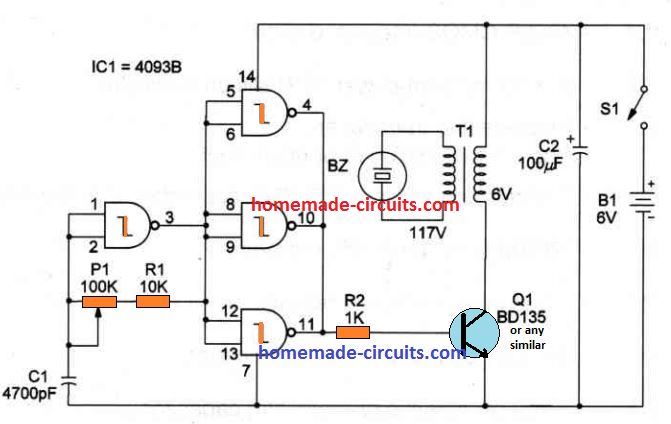
Parts List
- lC1 - 4093 IC
- Q1 - BD135 medium-power NPN silicon transistor
- BZ - Piezoelectric transducer
- T1 - Transformer: primary 110 VAC; secondary 6Vx100 mA
- R1 - 10K, 1/4W, 5% resistor
- R2 - 1K, 1/4W, 5% resistor
- P1 - 100K trimmer potentiometer
- C1 - 4.7nF ceramic or metal film capacitor
- C2 - 100 uF/16V
- S1 - SPST toggle or slide switch
- B1 - 6V or 9V - AA cells or battery - see text
IC 4093 Pinout Image
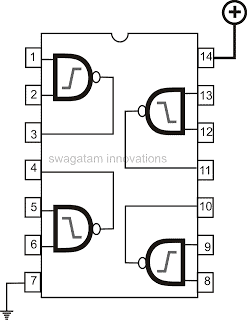
Piezo Transducer Image
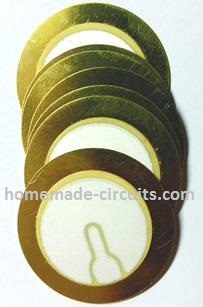
Components overlay and the PCB track layout can be seen in the following image.
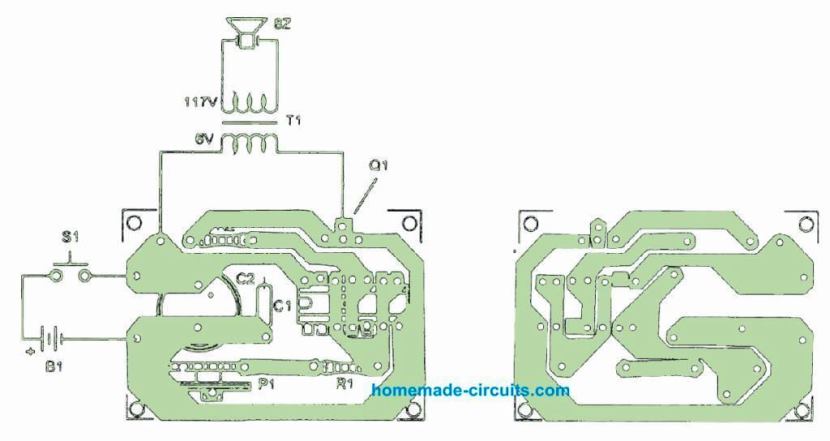
The entire circuit could be encased inside a compact plastic material container. The transducer or the piezo element may be installed on the front board.
Be careful with the placement of the parts that carry polarity, for example the transistor, electrolytic capacitor and power supply input. If the unit is intended to be operated continuously, make sure Q1 is mounted on a proper heatsink.
The transformer specs is not an important factor. Any transformer having a secondary coil ranging from 100 to 500 mA could be used in this ultrasonic pest repeller project.
Ideas you can Tweak Further
To find out more regarding the circuit or to improve its effectiveness:
- You could try replacing the piezoelectric transducer with a tweeter and check the response, whether it improves or not.
- Remove T1 and BZ and place the tweeter between positive line and the transistor collector. You might also try measuring the level of the generated ultrasound power?
- The circuit can also be tweaked to generate sound within the human listening range.
- This can be done simply by replacing C1 with any other capacitor having value in between 0.02 and 0.1 uF.
Insect Repeller using IC 555
Using an uninterrupted sound frequency to repel or attract insects may actually be possible in real life.
The range of frequency or depth may depend on the implementation and the type of pest, which can be perhaps determined through some trials.
The circuit displayed below produces a nonstop noise frequency you can use to push away (or draw in) several types of insects.
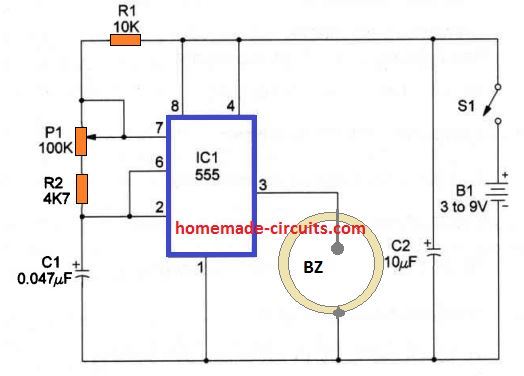
The circuit could be driven by 9V battery packs which may run for a long period of time due to its minimal current consumption. The center of the circuit is the 7555 lC, a CMOS timer configured as an sound oscillator which operates a piezoelectric transducer.
The parts positioning on a do-it-yourself PCB is revealed in the below given Figure.

Precise location may not be too critical. Each of the parts and the power supply could be enclosed in a compact plastic-type container. Transducer BZ can be a crystal earpiece or a piezoelectric transducer.
Location of the polarized items, like c2 and the power supply, should be cautiously wired.
Applying the insect repellent can be quite simple. You have to fine-tune he trimmer potentiometer P1 to generate a noise having the identical throw, matching the insect's range you would like to repel.
Trial and error has to be done before you uncover the ideal frequency to repel a certain insect.
Parts List
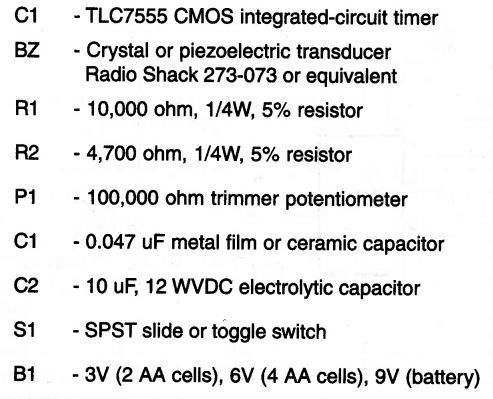
Pest Repellent Circuits which were Tested and Found Working
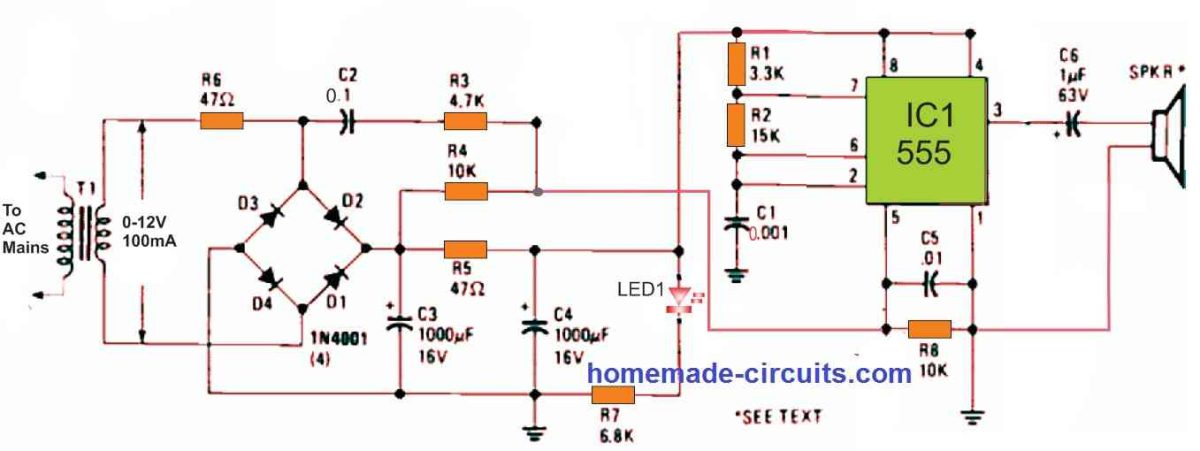
The circuit of the pest repeller we investigated is shown in Figure 1 above. We were startled to see that the circuit had only a single 555 timer IC wired in the manner of a squarewave generator. According to the parameters of R1, R2, and C1, its frequency was about 45 kHz.
A modified trapezoidal voltage waveform applied to pin 5 of the 555 timer modulates the 45-kHz carrier. A combination of C2, R3, and R4 linked across one endpoint of the bridge rectifier generates the modulating voltage. An oscilloscope examination revealed a sweep of roughly 20kHz on each side of the base frequency.
A 2 inch piezoelectric tweeter serves as the speaker.
The circuit shown in Figure 2 below is a pest repellent reported in one of the French electronics publications. The author says in the study that frequencies ranging from 20 to 40 kHz induce very painful cavities to develop in the brain fluids and blood arteries of mice and insects, leading them to flee. Radiated power could be as little as one-third of a watt.
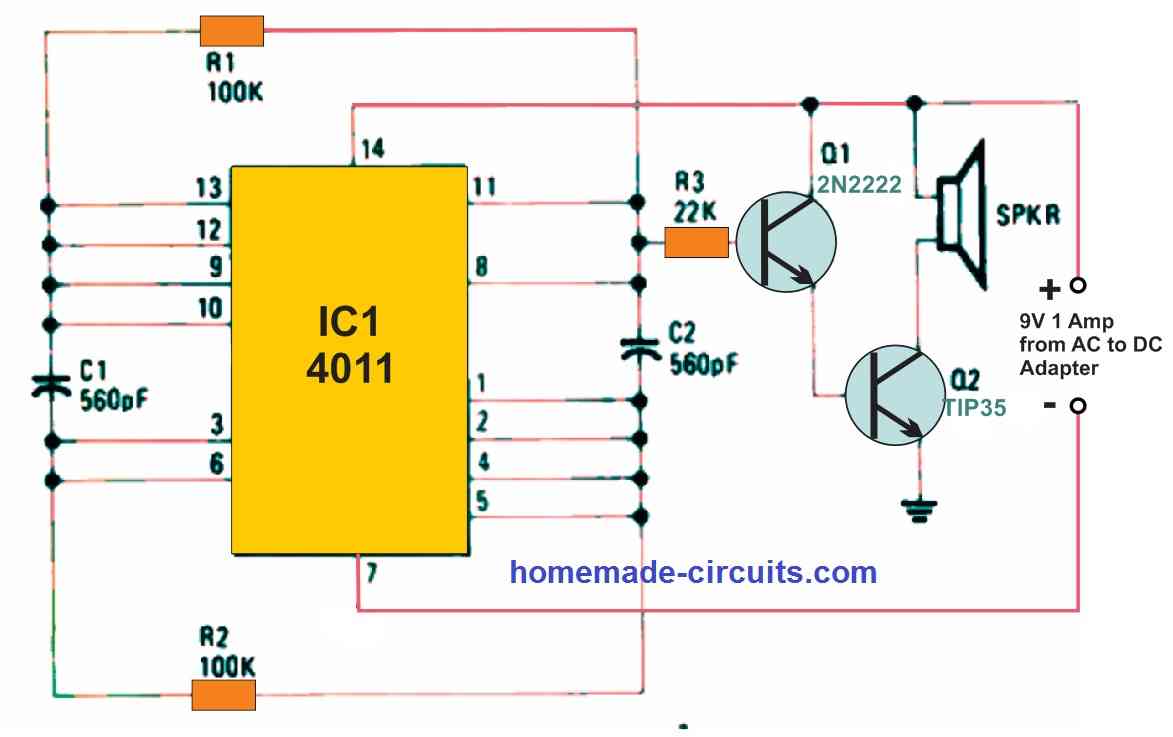
A quad two input NAND gate is wired as a multivibrator in the circuit, which operates at roughly 40 kHz. A residual 120 Hz sawtooth on the power supply line regulates the ultrasonic frequency with the least amount of filtering in the power supply.
A couple of Darlington-connected NPN transistors enable power amplification for driving the speaker optimally.
The circuit in Fig. 3 below is perfect for experimenting with the effects of continuous or pulsed high-frequency signals since it may provide either a continuous or pulsed output.
The idea was developed by Signetics.
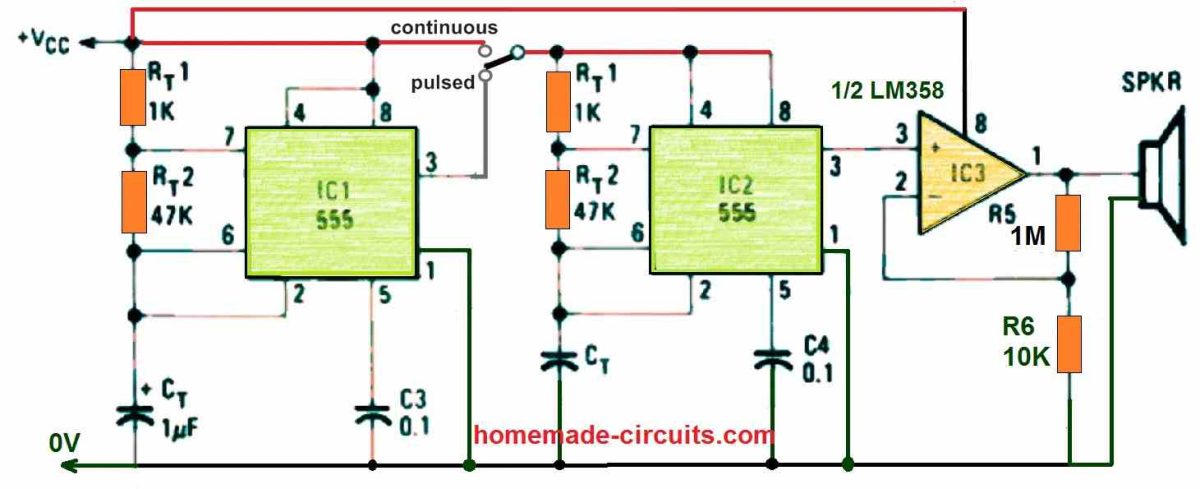
Referring to the circuit, one 555 timer, IC2, creates an ultrasonic squarewave at a desired frequency of 20 kHz. An additional 555, IC1, can provide that signal constantly or like an on and off switched signal.
It is simple to experiment with frequency and duty cycle. The duty cycle is the percentage of time spent "on" in comparison to the overall period, and it may be regulated from little more than 50% to nearly 100%. The duty cycle of the astable multvibrator circuit is determined by the timing resistors RT1 and RT2, and is equal to RT1 + (RT2 / RT1) + 2RT2.
The ON time could be expected to be 100% if RT1 is extremely small in value and while restricting the current via the discharge transistor to the maximum, as per the data sheet, the on time is near to 100 percent.
The 555's discharge transistor is an open-collector NPN device with the collector connected to pin 7 and the emitter connected to ground at pin 1. Because the maximum current through it varies depending on the manufacturer, you should double-check the manufacturer's data sheet to be safe.